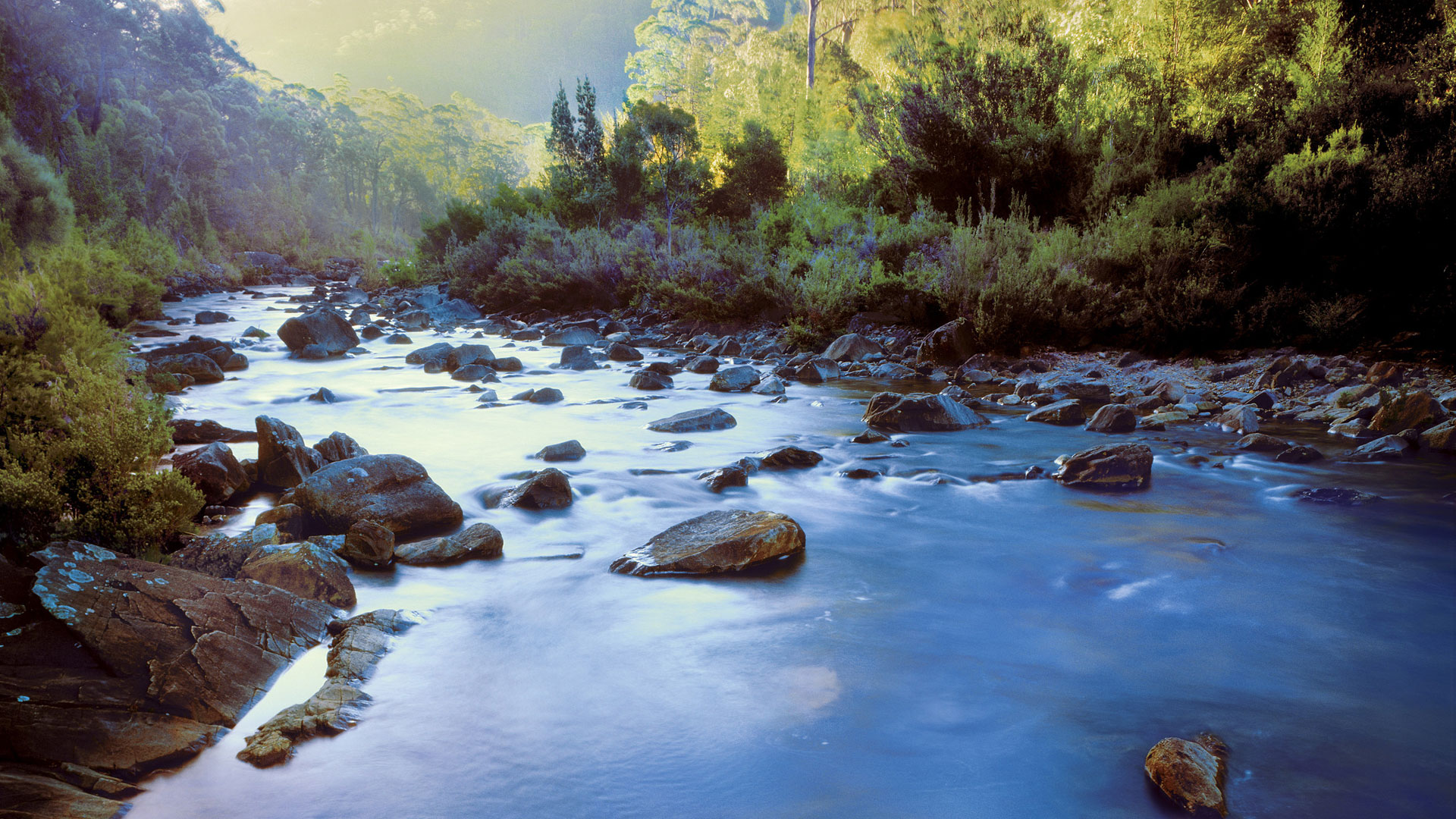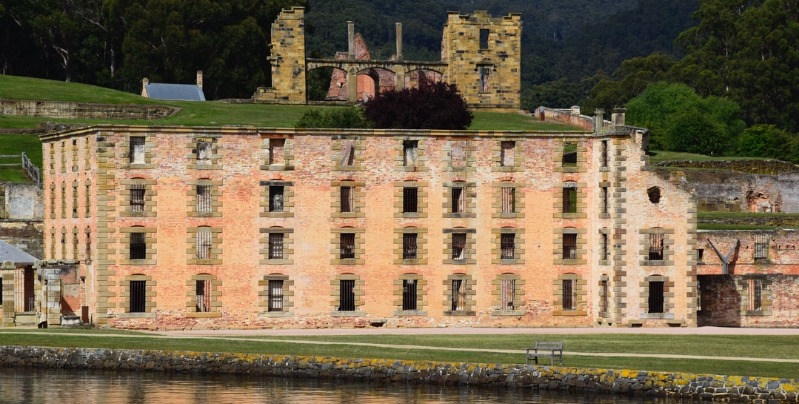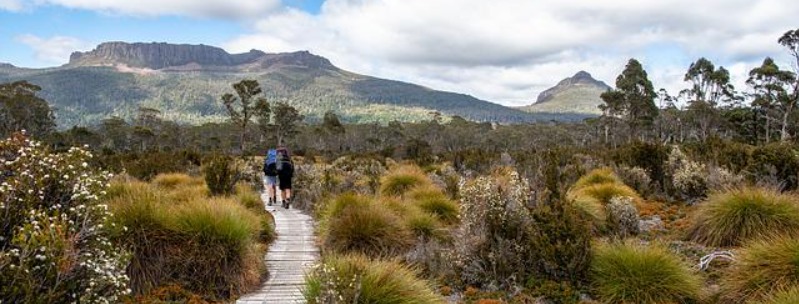Explore the Convict Trail in Tasmania
Embark on a truly adventurous Australian road trip by leaving the main continent behind and touring Tasmania! Located just 240km south of Australia’s main landmass and across the Bass Strait, this island state member of the Australian commonwealth offers many escapes from the ordinary for tourists and locals alike.
The state of Tasmania is actually comprised of 335 islands. Tasmania is the main one, and the 26th largest island in the world. Over 45% of its 68,000 square kilometers is held as national parks, reserves, or World Heritage sites.

The island is perfect to explore by car. It is a very drivable 364km from north to south and 306km from east to west, with well-developed roadways and little traffic. Hire a car once there, or bring one across from the continent on the Spirit of Tasmania – a ferry with passage between Melbourne, in Victoria and Devonport, in Northern Tasmania. The journey across the Strait will take about 8 hours, so you can use that time to map out your road trip itinerary, or just relax and enjoy the numerous ship-board accommodations.
5 World Heritage convict sites in Tasmania
The five World Heritage convict sites in Tasmania are Woolmers and Brickendon Estates, Darlington Probation Station, Coal Mines Historic Site, Port Arthur, and the Cascades Female Factory.
If you elect to arrive in Tasmania via the Spirit of Tasmania you will disembark at Devonport. From there a tour can be started at the convict sites at Woolmers and Brickendon Estates. This former agricultural estate is located outside of Longford, just 95km to the southeast of Devonport using Bass Highway/National Highway1.
Before Leaving Davenport
Stop by the Tiagarra Aboriginal Cultural Centre and Museum for information and over 2,000 exhibits about the original inhabitants of Tasmania. Over 12,000 years ago, Tasmania was joined to mainland of Australia, but rising sea levels separated the two areas. The Tasmanian Aboriginal people were cut off from the mainland and developed their own separate culture.
Prior to British colonization in the early 1800s, Aborigines numbered from 3,000-15,000 individuals. Today, there are no full blooded Aboriginal members left. Instead their art and traditions continue to be passed down. The cultural center is located on a sacred Aboriginal site, Mersey Bluff. The site has well-preserved ancient Aboriginal rock carvings that were discovered in 1929. Guided tours are available and locally made Aboriginal gifts are available.
Brickendon Historic Farm and Convict Village
The Brickendon Historic Farm and Convict Village was built in 1824 by the Archer family and has been owned and farmed by their descendants for six continuous generations. Convicts here were co-ed and provided labor for the settlers in exchange for food and clothing. Compared to the severe conditions at some of the other sites, this assignment was considered somewhat less arduous.
Visitors today can view several structures built by the convicts including Dutch barns, a blacksmith shop and Gothic chapel. There is also a 10 acre historic garden containing English and exotic trees dating from the 1830s, and various garden beds. There are numerous historical farm cottages for overnight stays, and animals for children to feed. Interestingly, the Archer family is known for never selling their possessions. This has resulted in an accidental time capsule containing heritage treasures.
Also in Longford
Visit the Woodstock Lagoon Wildlife Sanctuary, a 370 acre natural wetlands, nesting grounds and refuge for waterfowl and endangered species.
Continue southeast to the seaside town of Triabunna, about 173km from Longford. From there take a short ferry ride to Maria Island, home to the Darlington Probation Station. The location operated first as a convict station, then later as a probation station from 1842-1850. During this time, it was known for an extreme regime of surveillance and routine as a means to rehabilitation.
The all-male convict population was divided into 3 classes and they could advance from “convict” to “second” to “first” class based on good behavior. Conversely, bad behavior could merit a demotion in class or solitary confinement. Because so many of the original building have survived in such good condition, Darlington is considered the most typical and intact representation of the 78 total probation stations in Australia. Its 892 acres remain largely unchanged.
Little known fact
The whole of Maria Island is a national park. Outside of probation station, you can take your pick of outdoor activities like hiking, diving, swimming, and wildlife observation. Guided island walks can last for hours or days!
Back in Triabunna
The visitor’s center is an essential visit with a display of tapestries, and there’s also the Tasmanian Seafarer’s Memorial nearby. From there, there’s the option to go on to try delectable seafood, tour some coastal vineyards, enjoy a bushwalk or just spend time enjoying the many tearooms and galleries.
Coal Mines Historic Site
Coal Mines Historic Site is next. Drive about 119kn south from Triabunna to the Tasman Peninsula. This site was the first coal mine in Tasmania and was known for the severe punishment inflicted upon the convicts, including round the clock 8-hour shifts in appalling mine conditions. Other convicts built infrastructure by quarrying limestone, brick making and burning lime. Discipline included flogging and solitary cells. In fact, according to Parks and Wildlife Service Tasmania’s Coal Mines website, this was a “place of punishment for the worst class of convicts from Port Arthur”. Conditions at Coal Mines were so horrendous that it was closed on moral and economic grounds in 1848. It was used as an example to sway British opinion and helped lead to the end of the probation system.
The location today is lovely. There are over 528 largely undisturbed acres holding 25 substantial buildings and coal mining remnants. Admission is free and the site is open daily with no reservations required. Stay on trails and wear quality walking shoes. The main settlement and Plunkett point (about 300 meters of track) are wheelchair accessible, but the rest – including the track up to the Main Shaft – is not. You can experience living history with a stay in a historic bed and breakfast in the area. From there it is easy to enjoy other Tasman peninsula attractions.
Tasman Peninsula extra
Take a drive through Doo town, a holiday village where about 130 cottages have been given names which contain “doo”. The tradition was started by a Hobart architect, Eric Round. The town overlooks the southern end of Pirates Bay and makes for a one-of-a-kind photo opportunity.
Port Arthur
A short 10km down the road is Port Arthur, the most famous tourist attraction in Tasmania, and home to arguably the best preserved and one of the most important Australian convict sites. From 1833-1877 it operated as a convict station for secondary offenders. It was run by Lieutenant Governor Arthur, who envisioned it as “a place of terror”. He accomplished this vision with a combination of never-ending surveillance ad hard labor. Convicts felled lumber and quarried sandstone. Recidivists at the camp were confined to the separate prison. There, the days consisted of 23 hours of solitary confinement and 1 hour of exercise – all conducted in absolute silence.

Port Arthur is distinguished from the other Tasmanian convict sites by the overwhelming amount of options presented to visitors. Besides guided and audio tours, there are harbor cruises, multimedia presentations, furnished houses, an interpretation gallery, museum displays and high-tech experiences at the separate prison and dockyard. For an additional fee, there’s a guided tour of Port Arthur’s island burial ground with a cruise to the Isle of the Dead. There is even a night-time, lamp-lit ghost tour and a new late-night, adults only Paranormal Investigation Experience!
Accommodations range from campsites to luxury cabins and everything in-between. Site admission is good for two consecutive days; visitors should stay a while to fully appreciate all this small town has to offer.
Point Puer Boys’ Prison
Other sites of interest covered by admission include the Commandant’s Residence, Government Gardens. For a small additional fee, you can go across the harbor to see the Point Puer Boys’ Prison. This prison was the first to be built in the British Empire exclusively for juveniles. Between 1834 and 1849, over 3,000 boys were sentenced to this reformatory. Some were just 9 years old. The place was known to be stern and harsh. Walking tours of the prison take place outside and are not recommended for those with mobility issues. Allow 2 hours.
Also To try in Port Arthur
A 3 hour eco-cruise highlighting the coastline of the Tasman Island National Park. You might even catch sight of some seals!
Cascades Female Factory
The last of the five Tasmanian convict sites is Cascades Female Factory. To get there, it’s a scenic, 98km drive from Port Arthur using the Arthur Highway, via the commuter town of Sorell, to the A3/Tasman Highway and end in Hobart, the state capital.
Cascades Female factory operated from 1828 through 1856 and was for the punishment and rehabilitation of girls, women and their babies. It is the most significant of the four convict institutions that were specifically designated for females, and the only one with surviving buildings that give a glimpse of what life was life for the inmates. Three of the original five yards remain.
In order to remove the women from the negative influences of Hobart, and simultaneously protect society from the immorality of the female convicts, the Factory was built in a valley at the base of Mount Wellington. Despite the isolated location, Cascades women provided laundry services, sewed clothes, spun yarn and did needlework. This significantly contributed to the offsetting the costs of the penal colony and was very important to the penal transportation system. The labor of over 25,000 female convicts contributed to the development of the colonies, and they provided greater social cohesion through the formation of families.
The original factory was built to accommodate 250 women and included a hospital, nursery, and church along with stores, laundries, workshops and offices, among other buildings. Things went downhill quickly. Within 10 years, despite having a high birth rate, the infant mortality rate at Cascades was 25%. Within 14 years the population of inmates topped 500. The factory became infamous for overcrowding and disease.
Today, visitors can experience a first-hand look at the harsh conditions of the factory circa 1833 with 45 minute performance of Her Story. In this history lesson masquerading as a roaming show, one actor portrays an inmate and another portrays an overseer and doctor. Separate 45 minute guided tours are also available.
For something different in Hobart
Arrange a kayak tour for a unique perspective of the Hobart waterfront. Tours last about 2 hours and children as young as 12 months can participate! Available from September through May.
Road Safety Tips for Tasmania
Preparation plays an important role in all travel planning, and an Australian road trip is no different. In particular for Tasmania, travelers need only keep the following tips in mind to ensure the smoothest experience possible:
- Roads are generally not crowded, but they can be steep or winding. This is especially true on Tasmania’s west coast. Allow extra time between destinations, and drive carefully.
- Winter months may bring snow on the roads, but it is unlikely drivers will need snow tires.
- Fuel can be hard to obtain off of the more developed routes. Travelers should fuel up before going long distances to out of the way locations. For example, to the west of Davenport, between the towns of Marrawah and Zeeha there is no fuel available for the entire 256km distance.
- The road designations in Tasmania indicate their condition. “A” designated roads (like the A3) are sealed major highways. “B” designated roads are sealed secondary roads and “C” designated roads are generally unsealed – and may be subject to special conditions in car hire contracts.
- Tasmania has an abundant spectrum of wildlife, from the well-known Tasmanian Devil to the dwarf tree frog. Drivers should be extra vigilant for them on the roads especially at dawn and dusk.
History of Tasmania
Tasmania (or Tassie colloquially) played a large role in Australia’s convict history. In fact, five of the eleven Australian convict sites recently named to the UNESCO World Heritage List are located on this formal penal colony island. A trip to these sites affords a rare opportunity to step back in time to experience one of the most famous chapters of Australian history. Going by car allows you to set your own pace and craft a tour specific to your interests. Without the pressure of meeting tour-group deadlines, road-trippers can enjoy as much or as little of the sites and surrounding towns and areas as desired.
Many of the sites kept valuable records of convict history, and anyone interested in tracing ancestors back along the convict trail will find unique sources of information, the likes of which do not exist elsewhere in the world. While this may be of particular interest to tourists from the Australia or the United Kingdom, anyone can marvel at these outstanding examples of the world’s convict era. As noted in the Executive summary of Australian convict sites: World Heritage Nomination, by the Commonwealth of Australia: Department of the Environment, Water, Heritage and the Arts, visitors will find sites that provide “an extraordinary example of global ideas and developments associated with the punishment and reform of the criminal elements of humanity during the Age of Enlightenment and the modern era.”
Convicted men, women and children as young as nine years of age lived and laboured at factories, stations and estates dating back to the 1820s. There were four factories specifically designated for female populations and their babies. In addition to the convicts, these posts housed other personnel like civilians, soldiers and their families.
The ultimate goal for most convicts was rehabilitation, and this was attempted via means of hard labour, physical discipline and moral and spiritual education. Those sentenced to the various institutions provided skilled labor like blacksmithing, unskilled labor like rock-breaking, agricultural labor and domestic services. Their efforts contributed greatly to the economy and helped finance the survival of the colony. Additionally they created important elements of Tasmania’s infrastructure, some of which survive to this day like the Ross Bridge.
Final Word
Tasmania is a compact island packed with the potential for adventure! Its pristine wilderness, unique historical offerings and open roads make it the perfect Australian road-trip travel destination. Primarily, the island offers tourists an abundance of flora and fauna in over 30,000 square kilometers of preserved lands where it is possible to see many unique and near-extinct species.
A trip around the Tasmanian convict sites provides a fascinating insight into the development of the island and Australia. A driving tour of Woolmers and Brickendon Estates, Darlington Probation Station, Coal Mines Historic Site, Port Arthur, and the Cascades Female Factory can be easily spread out over a one or two week visit, or even over a few weekends, and will take you to the North, East and South of Tasmania. Build an itinerary incorporating the locations that contain these sites including Davenport, Longford, Triabunna, Maria Island, Port Arthur and Hobart, then branch out as time and inclination permit!
